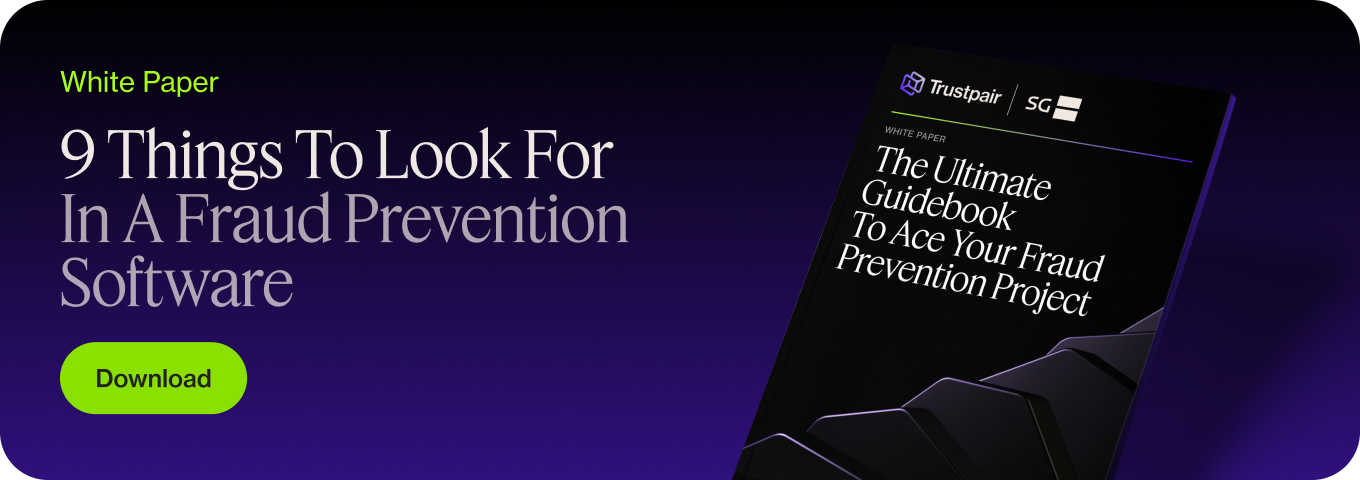In a time where 6 out of 10 US companies are targeted by at least one fraud attempt each year, fraud prevention is a critical issue. The most effective way to prevent payment fraud is by implementing a fraud prevention solution. Baptiste Collot, CEO of Trustpair, takes us through all the steps and criteria to make sure your project is successful.
Download our Fraud Prevention Guidebook for more tips by experts from Trustpair, BearingPoint and Société Générale.
- My first question is a bit of an introduction. What’s your assessment of fraud today? What is the state of play of fraud in the US? Is the risk rising, or decreasing?
Honestly, the situation is the same as in Europe: the risks are the same. The criminals are cross-frontier you know: the people who embezzle money do it worldwide. The methods used are similar.
The difference that I see in the United States is that there is a growing adoption of electronic transfers vs paper checks. The switch from checks to wire transfers creates a new need for data control, with a very large volume of data suddenly out there. And of course volume of data means opportunities for fraudsters. Another factor is instant payments, obviously. It’s also a new risk and a new loophole for fraudsters.
Overall, I’d say the American market is more educated than the European market. They understand the risks better and are more educated to topics like phishing for example.
- How do you rate the level of maturity of prospects in the US on the subject of combating fraud? What is the degree of prioritization of this subject vs other subjects?
There are 2 types of players in the fight against fraud, The ones who have been defrauded or have been very close to being defrauded and who therefore generally have a sense of urgency. And the others.
Often, fraud prevention is part of a larger project of process optimization and redesign of the P2P process. That’s why there’s more people involved in fraud prevention projects than before.
Historically, the prevention of transfer fraud was essentially the responsibility of treasury departments, but more and more, we’re seeing that procurement functions are getting involved, so as other teams.
There’s a need to control vendor data as upstream as possible in the P2P process, and this involves other teams than the Treasury Team.
- So you’re saying that defrauded companies obviously take an interest in fraud prevention. But what about the others? Companies who haven’t been defrauded? Do they take the subject seriously?
It’s a subject that’s always present because it’s a big topic in the media. However, it is a topic that demands bandwidth and therefore needs to be prioritized at some point of time. There’s still a lot of evangelism that needs to be done around these subjects
In the US many companies are always on the lookout for innovative solutions and we meet companies that are just looking around without necessarily taking action. They need to estimate the budget, put the topic in the roadmap, and so on. It’s a process that can take months, or years, before anything actually happens.
- And for companies that actually want to launch a project, what are the biggest blockers?
Budget obviously but also prioritization with other projects and bandwidth. It’s also not easy to identify who should have the ownership of the project.
- What are the main steps you need to follow to make sure your project is a success?
The pre-requisite is to understand the issue. To understand what’s going on, you need to address all stakeholders and ask them the right questions. Is it a process issue? Is it a tool issue? What exists on the market that could address my specific needs?
We often see that companies have big ideas on what they want. But honestly, the important thing is to actually start somewhere. Company processes are generally complex and don’t really match the ideal fraud prevention solution they’d like.
So you need to understand your needs and define your scope with precise milestones: companies sometimes have to cut up the project in different parts to make it work. Sometimes you can start by testing the solution on one entity of the company for example. You need to be realistic about expectations: think short term impact and efficiency.
- What features and criteria should you prioritize to select a fraud prevention solution?
What’s important is having one single platform to handle all vendors. You need to be able to handle specific cases: there can’t be any exception or vendor that’s being assessed somewhere else. Because exceptions are the gateway to fraud.
You need to have accurate and reliable account validation to make sure your vendor data is always secure and be alerted in case of any anomaly or suspicious change. Workflows are also important: they’ll enable teams to work easily and efficiently together.
I guess one of the key features is automated controls just before payment campaigns: this stage in the P2P process is very sensitive and easily targeted by fraudsters.
- What advice would you give to companies that want to launch a fraud prevention project?
The first advice would be having a clear ownership from the start and identify all stakeholders. Many companies have a wait-and-see posture when it comes to fraud. Unfortunately, the fraud industry is massive and industrialized: waiting just isn’t enough.
On top of that, organizations tend to look for the perfect solution that matches 100% of their expectations. By doing that they’re pushing back the day they’ll actually be protected against fraud. They should get into the game as soon as possible to lower the risk immediately.

